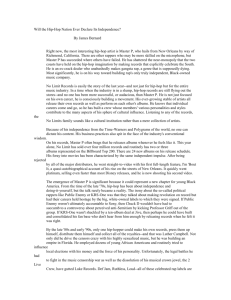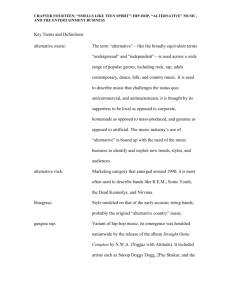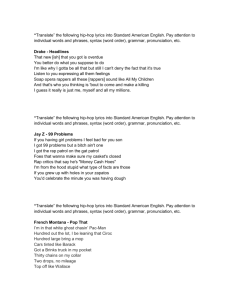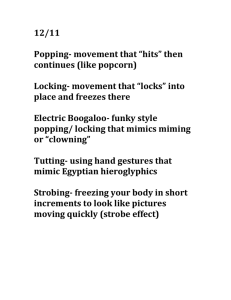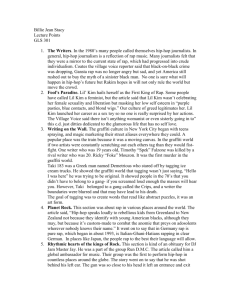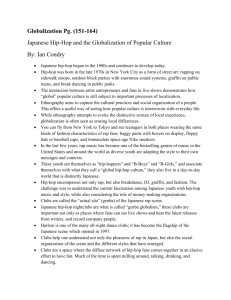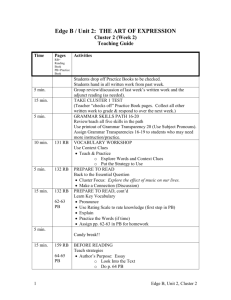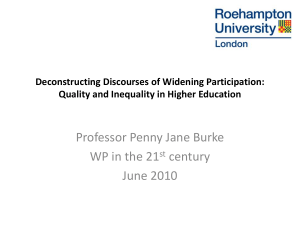Hip-Hop Culture and African
advertisement
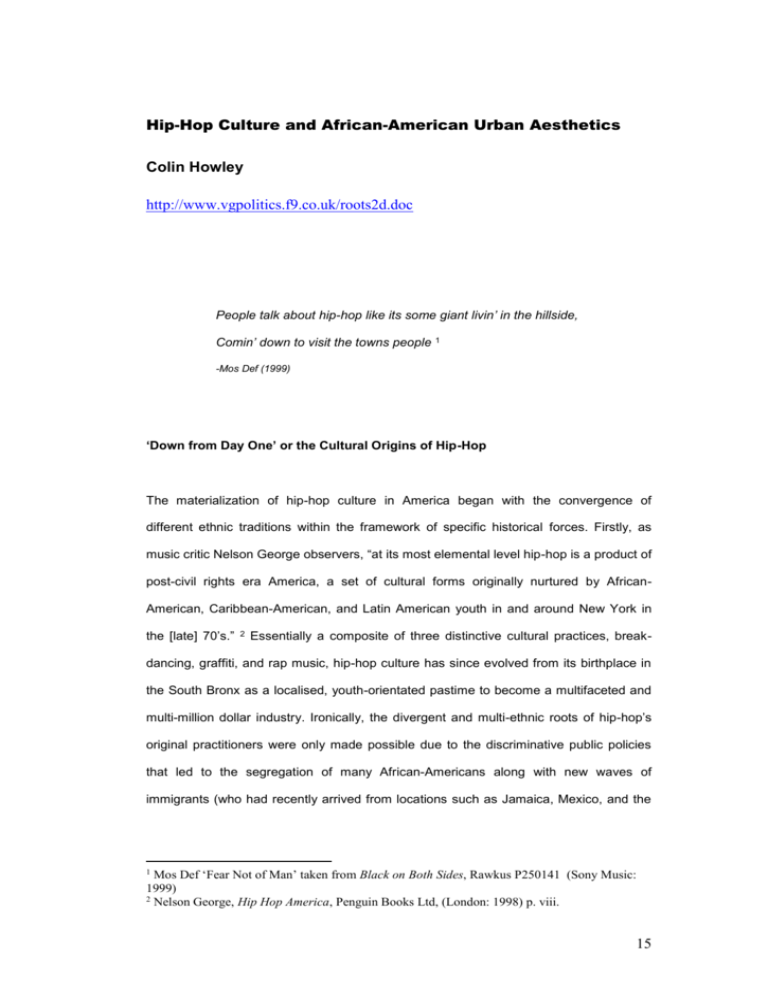
Hip-Hop Culture and African-American Urban Aesthetics Colin Howley http://www.vgpolitics.f9.co.uk/roots2d.doc People talk about hip-hop like its some giant livin’ in the hillside, Comin’ down to visit the towns people 1 -Mos Def (1999) ‘Down from Day One’ or the Cultural Origins of Hip-Hop The materialization of hip-hop culture in America began with the convergence of different ethnic traditions within the framework of specific historical forces. Firstly, as music critic Nelson George observers, “at its most elemental level hip-hop is a product of post-civil rights era America, a set of cultural forms originally nurtured by AfricanAmerican, Caribbean-American, and Latin American youth in and around New York in the [late] 70’s.” 2 Essentially a composite of three distinctive cultural practices, break- dancing, graffiti, and rap music, hip-hop culture has since evolved from its birthplace in the South Bronx as a localised, youth-orientated pastime to become a multifaceted and multi-million dollar industry. Ironically, the divergent and multi-ethnic roots of hip-hop’s original practitioners were only made possible due to the discriminative public policies that led to the segregation of many African-Americans along with new waves of immigrants (who had recently arrived from locations such as Jamaica, Mexico, and the Mos Def ‘Fear Not of Man’ taken from Black on Both Sides, Rawkus P250141 (Sony Music: 1999) 2 Nelson George, Hip Hop America, Penguin Books Ltd, (London: 1998) p. viii. 1 15 commonwealth state of Puerto Rico) in shared inner city districts or second ghetto. 3 Secondly and directly related to its historical context, hip-hop is fundamentally an urban cultural phenomenon whose style, sound, lyrics, and thematic are inscribed with the codes of existence as lived on the outer-limits of postindustrial America. Cultural historian Tricia Rose highlights this social and ideological basis of the culture in Black Noise, when she explains: [Hip-Hop]…emerges from the deindustrialization meltdown where social alienation, prophetic imagination, and yearning intersect [and]…is a cultural form that attempts to negotiate the experiences of marginalization, brutally truncated opportunity, and oppression. […] It is the tension between the cultural fractures produced by postindustrial oppression and the binding ties of black cultural expressivity that sets the critical frame for the development of hip hop. 4 At the forefront of Rose’s analysis is a correlation between the lack of opportunities for second ghetto residents under the conditions of late capitalism and hip-hop culture functioning as a rare mode of expression for those who, through the same conditions, are traditionally denied access to the means by which to participate in broader cultural discourses. Indeed, as Vibe journalist Alan Light asserts, hip-hop “is about giving voice to a black community otherwise underrepresented [and it]…has always been and remains directly connected with the streets from which it came.” 5 The Significance of Locality and Cultural Authenticity The term ‘second ghetto’ is used to distinguish the experiences of mainly European immigrants who first inhabited the ghettoised inner city before the suburbanization drive of the 1940’s and 50’s, and that of African-Americans and Latino immigrants who followed. 4 Tricia Rose, Black Noise: Rap Music and Black Culture in Contemporary America, Wesleyan University Press (London: 1994) p. 21. 5 Alan Light ‘About a Salary or Reality?: Rap’s Recurrent Conflict’ in Anthony DeCurtis (ed.), Present Tense: Rock and Roll and Culture, Duke University Press (London: 1992) p. 232. 3 16 The association with the ‘street’ remains the major thematic in hip-hop culture. On the one hand, it is symptomatic of the postindustrial climate that surrounded the culture at its conception and has continued throughout its development. New York in particular “led other old, industrial metropolitan areas into population and employment decline” during the 1970’s, and once the state declared itself bankrupt after President Ford initially vetoed a federal rescue plan it became a national symbol for the fate of older cities under his administration.6 Although the state finally negotiated a federal loan, the restructuring of the public sector that followed involved the removal of 60,000 city employees from the payroll and drastic cuts in social and public services. 7 During the same period, New York City encountered a public housing crisis that continued unabated well into the following decade and those citizens who made up the bottom twenty percent of the population also witnessed an absolute decline in income. 8 As the bottom fifth disproportionately comprised of African-American and Hispanic populations, it was the residents of the second ghetto who more than any other section of the city were subject to the socio-economical fall-out of local government mismanagement and industrial decline. Similar circumstances befell the vast majority of American cities in the interim, and the effects upon second ghettos ranged from occupational shifts that consolidated permanent unemployment and low paid service sector jobs as the norm, to the reshaping of public space itself in the form of urban renewal programs and restrictive methods of urban surveillance and regulation. Faced with these problems, the outcome for many in the second ghettos was to set a limit upon their prospects for social mobility. To a certain degree, this explains the tendency in hip-hop culture to emphasise the street. Confined to disenfranchised districts of the city the street locality has become the epicentre of daily life for the residents of the second ghetto and the boundary within which the majority of social encounters and economical transactions take place. 6 John Mollenkopf, The Contested City, Princeton University Press (Princeton, NJ: 1983) p. 213. Daniel Walkowitz, ‘New York: A Tale of Two Cities, in, Richard Bernard (ed.), Snowbelt Cities: Metropolitan Politics in the Northeast and Midwest since WWII, Indiana University Press (Bloomington: 1990) p. 204. 8 Robert Neuwirth, ‘Housing after Koch’ in Village Voice, 7th November 1989, p. 22-24. 7 17 On the other hand, and not unrelated to limited social mobility, the resonance of the street within hip-hop culture also intimates how locality functions as an alternative source from which identity can be established. As Rose reasons, “identity in hip-hop is deeply rooted in the specific, the local experience, and one’s attachment to and status in a local group or local community.” 9 Prior to hip-hop’s infiltration of the visual and aural medias in America, the official channels responsible for relaying the images of the nation often monopolized and constrained the diverse flow of available information. According to cultural critics Mitchell Moss and Sarah Ludwig, this resulted in a dual “crisis of representation.” 10 In effect, not only were white middle-class values normalised in the media and the corridors of power, but the representations of the second ghetto also perpetuated the common fears and anxieties about race for the American imaginary. Therefore, denied proper representation in the media and without access to institutional support due to public spending cut backs, hip-hop culture offered a communal resource that enabled a marginalized urban youth to reshape their identity and cultural expressions on their own terms within distinctive social groups or crews. Unlike the residents of the first ghetto and to a lesser extent the second ghetto generation before them, hip-hop crews were not exclusively divided along lines of race. One explanation for this arises from the urban renewal programs of the 70’s that evacuated established and separate racial blocks of the inner city, usually earmarked for lucrative redevelopment, and relocated a diverse ethnic populace into isolated project space. In this new multi-ethnic urban terrain, many of the residents not only shared a common colonial and slave heritage, but also encountered the same discriminative practices in the present. As Robin Kelly observes, “by linking their identity to the ‘hood’ [or street] instead of simply skin color…[hip-hop culture] implicitly acknowledge[s] the 9 Tricia Rose, Black Noise: Rap Music and Black Culture in Contemporary America, p. 34. Mitchell Moss and Sarah Ludwig, ‘The Structure of the Media’ in York, John Molenkopf and Manuel Castells (ed.), Dual City: Restructuring New Russell Sage Foundation (New York: 1991) p. 245. 10 18 limitations of race politics [and recognises that]…the experiences of young black men in the inner city are not universal to all black people.” 11 To be sure, the responses to the second ghetto and hip-hop culture from middle-class African-Americans often replicated, and in certain instances exceeded, the condemnation from white America. For many in the hip-hop community the AfricanAmerican middle-class has been guilty of deserting ‘their own’ within the second ghetto, and the complicity of African-American politicians with white corporate America was repeatedly criticised. Musicologist Adam Krims highlights the disparity between hip-hop culture and an African-American middle-class who are considered sell-outs when he comments, “one of the principal validating strategies of rap [music in particular and hiphop culture in general] involves ‘representing’ and ‘keeping it real’ [or]…deploying authenticity symbolically.” 12 In other words, by rejecting hip-hop as a true mode of African-American cultural expression and implicitly the experiences of its practitioners, middle-class African-America distances itself from the second ghetto and from the vantage point of suburbia is not ‘representing’ the commonality of ethnicity, but advancing “interracial class segregation.” 13 More recently, the issue of locality that continues to stratify the African-American population along the lines of class has evolved into regional conflicts within hip-hop culture. There has been an extensive history of symbolic and verbal challenging with the culture, as Rose stresses, “hip-hop remains a never-ending battle for status, prestige, and group adoration, always in formation, always contested, and never fully achieved.” 14 Indeed, it is for many practitioners a vital element in break-dancing, graffiti, and rap because it encourages one-up-man-ship and produces continuous innovation and new stylistics. However, in the mid 1990’s the escalation of regional conflict between members of the hip-hop community reached new heights. Initially, the rivalry between 11 Robin D. G. Kelly, Race Rebels: Culture, Politics, and the Black Working Class, The Free Press (New York: 1996) p. 210. 12 Adam Krims, Rap Music and the Poetics of Identity, Cambridge University Press (Cambridge: 2000) p. 48. 13 Robin D. G. Kelly, Race Rebels: Culture, Politics, and the Black Working Class, p. 211. 19 Tupac Shakur of Surge Knight’s Los Angeles based Death Row Records and Christopher Wallace (aka Notorious B.I.G. aka Biggie Smalls) of Sean ‘Puffy’ Combs’ Bad Boy label in New York City was played out in the media more than anywhere else. Promoted as a battle amongst East Coast and West Coast ‘gansta’ rappers, many considered it a mere stunt to boost the international profile of artists and record companies alike until the near-fatal shooting of Tupac in 1994, and his subsequent death from another shooting in the fall of 1996 while attending a Mike Tyson fight in Las Vegas. Following the two incidents recriminations abounded and the rivalry intensified finally resulting in the murder of Wallace in the spring of 1997 during a tour of Los Angeles, which in common with Tupac remains a still-unsolved homicide. In the aftermath of these bloody events, the hip hop community has attempted to take stock of the problems endemic in regional differentials with label led ‘Stop the Violence’ campaigns and self-organised annual conferences that provide a forum from which to address collective concerns. Hip-Hop Aesthetics and African-American Cultural Traditions Out of all the forms and practices that comprise-hip hop, rap music is most readily associated with African-American cultural production. Paul Gilroy contends: The hybridity which is formally intrinsic to hip-hop has not been able to prevent that style from being used as an especially potent sign and symbol or racial authenticity. It is significant that when this happens the term hip hop is often forsaken in favour of the alternative term ‘rap’, preferred precisely because it is more ethnically marked than the other. 15 14 Tricia Rose, Black Noise: Rap Music and Black Culture in Contemporary America, p. 36. Paul Gilroy ‘Sounds Authentic: Black Music, Ethnicity, and the Challenge of a Changing Same’ in Sidney Lemelle & Robin D.G. Kelly (ed.) Imagining Home: Race, Culture, Class, and Nationalism in the African Diaspora, Verso (London: 1994) p. 112. 15 20 However, that is not to say rap music is the exclusive domain of African-Americans, and any assertion to the contrary is problematized by the success both within the hip-hop community and the mainstream of non-African American artists. Notable examples, ignoring the regrettable Vanilla Ice, include American-Jewish Beastie Boys, AmericanIrish House of Pain, American-Hispanic Cypress Hill, and Anglo-American Marshall Mathers (aka Eminem, aka Slim Shady). Nonetheless, rap music at its most elemental according to many music and cultural critics is, as Todd Boyd ascertains, “an extension of the Black oral tradition and the legacy of Black music and its relationship to the cultural landscape of America.”16 To a certain extent, the organisation of raps primary sonic properties is a hybrid of Afrodiasporic sounds and displays influences from multifarious African-American musical traditions as well as Caribbean toasting rituals; a fact exemplified in the ethnic backgrounds of raps founding fathers, African-American rapper African Bambaataa and the Jamaican born DJ pioneer Kool Herc. In the early history of rap’s cultural production, sonic output was provided by a DJ’s break-beats and the oral dexterity of an MC (Microphone Controller), both of which are still essential in its present format. The break-beat, a section of a record where “the band breaks down [and] the rhythm section is isolated” and with the use of two turntables and usually two copies of the same record forms a continuous loop, is the musical backbone of rap.17 Ubiquitous with the aesthetics of other Afrocentic musical traditions, the breakbeat emphasises polyrhythmic rather than classical Western harmonic sonic qualities, even when the overall sound of the source recording may not necessarily do so. Similarly, the vocal register or lyrical flow of rap is also predicated on polyrhythmic techniques, and even though the approach of MC’s is varied, lyrical flow is as Krims observes, a “percussion-effusive style…[where] the rhythmic patterns are constantly shifting” 18 These practices intersect with much recent African-American critical theory. Houston Baker, Jr. suggests “the vernacular [which] in its expressive adequacy and Todd Boyd, Am I Black Enough For You? : Popular Culture From the ‘Hood and Beyond, Indiana University Press (Indianapolis: 1997) p. 34. 17 Grandmaster Flash quoted in Tricia Rose, Black Noise: Rap Music and Black Culture in Contemporary America, p. 73. 18 Adam Krims, Rap Music and the Poetics of Identity, p. 67. 16 21 adept critical facility always absorbs classical elements of American life and art” is the paradigm for African-American cultural production.19 Implicit in the process is the annexing of ‘classical’ or dominant white American discourses. Yet, rather than merely transplanted repetitively from one context and assimilated into another, the linguistic practice in Henry Louis Gates, Jr. opinion “encodes and names its sense of independence through a rhetorical process we might think of as the signifyin(g) of black difference.”20 Hence, African-Americans establish autonomy through the distinctive nuances of their language use (the parentheses in the term ‘signifyin(g)’ denotes the difference between the official literal or written meaning and the unofficial figurative or oral ways of meaning), and effectively, signifyin(g) operates as a double-discourse or heteroglossia, enabling the language user to participate in two social contexts and communicate symbolic values through orders of meaning. Break-beats and lyrical flow both demonstrate how elements of signifyin(g) operate at the level of production and reception to generate encoded meanings, which as Kalamu ya Salaam notes, are “difficult for adults in general, as well as non-blacks specifically, to understand.”21 However, it is the advancement of digital sampling that has come to exemplify and revolutionize the process of signifyin(g). For George, sampling represents the “moulding of technology to fit a black aesthetic [that has] became a hallmark of hiphop.” 22 The use of electronic equipment in rap production was not straightforwardly adopted; it significantly modifies technologies in ways that were in keeping with AfricanAmerican cultural traditions, such as repetitive rhythmic loops or beats and bass frequencies that were first pioneered in Afrodiasporic musical form of dub reggae. Rose’s observations on sampling in particular, with its layers of found or second-hand sounds, underscore the revisionist and inscriptive aesthetic practices of AfricanAmerican cultural production as specified in the research of Baker and Gates: 19 Houston A. Baker, Jr. Blues, Ideology, and Afro-American Literature: A Vernacular History, The University of Chicago Press, London (1987) p. 12. 20 Henry Louis Gates, Jr. The Signifying Monkey: A Theory of African American Literary Criticism, Oxford University Press, Oxford (1989) p. 66. 21 Kalamu ya Salaam, ‘It Didn’t Jes Grew: The Social and Aesthetic Significance of African American Music’, African American Review, Vol. 29, No. 2 (1995), p. 371. 22 Nelson George, Hip Hop America, Penguin Books Ltd, p. 27. 22 Sound systems [in rap music] are at once deconstructive…in that they actually take apart recorded musical compositions [and] recuperative…because they recontextualize these elements creating new meanings for cultural sounds that have been relegated to commercial wastebins. 23 The creation of new meanings is an essential element in hip-hop culture and is not isolated only to musical production. Whereas locality and style often facilitate the construction of group identity, the prolific practice of self-naming is a method of reinvention and self-definition operating on an individual basis. Taking on a new name is widespread in many Afrodiasporic cultures, but in the context of America’s history, it acquires particular significance. Literary critic Kimberly Benston highlights how in the slave narratives of nineteenth-century self-naming is an act “affirming at once autonomy and identification”, and in the 1960’s a similar rationale prompted the acquisition of new Afrocentric and Islamic names in the Black Nationalist and Black Muslim movements. 24 The basis for these new identities can come from the most unlikely of sources, often reestablishing and reinvigorating maligned moments and figures from African-American history. For example, to compound his gansta credentials the Los Angeles rapper Ice T appropriated his moniker from the legendary underground writer Robert Beck, whose 1960’s novels of criminal life in Chicago’s Southside appeared under the pseudonym Iceberg Slim. Similarly, rappers such as Rakeem and Black use their Islamic and Afrodiasporic names to express personal politics, while others, for instance Cannibal Ox draw influences from the under-valued genre of African-American science fiction. Yet, there is a danger of overstating the political dimension of African-American cultural production in hip-hop practices. As cultural critic Michael Dyson comments: 23 Tricia Rose, Black Noise: Rap Music and Black Culture in Contemporary America, p. 65. Kimberly A. Benston ‘I yam what I yam: the topos of un(naming) in Afro-American Literature in Henry Louis Gates Jr. (ed.), Black Literature and Literary Theory, Oxford University Press (London: 1991) p. 156. 24 23 Black culture is not simply formed in the response to the forces of oppression. Its purposes do not easily reduce to resisting racism. Although black cultural creativity and agency are profoundly influenced by racist oppression, their range of expressions are not exhausted by preoccupation with such oppression.25 Clearly then, hip-hop culture emerged within the specific conditions of American postindustrialization and was, and still is, essentially developed among a section of the population most prone to the ebb and flow of global capitalism, the whims of public policy making, and endemic institutionalised racism. However, strategies of deconstruction and recontexualization, such as the recycling of old records and renaming are primarily artistic acts of creation and should not be mistook as homogenised acts of resistance. Moreover, these aesthetic practices are essentially motivated in order to fulfil the pleasure and respect rewarded to its practitioners and the desire and satisfaction derived from its patrons. In addition, as hip-hop is also a culture of networks and loose affiliations, its importance is highly dependant on those who have accessed to it. This goes some way to explaining why it is a cultural practice that continues to both include and exclude many on the basis of race, gender, and class. Email Letters Of Reply To: roots@vanguard-online.co.uk 25 Michael Dyson, Reflecting Black: African-American Cultural Criticism, University of Minnesota Press (London: 1993) p. xvii. 24
